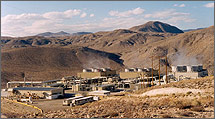“Renewable” or “Sustainable” When is an energy source “renewable” and under what conditions is the same energy source “sustainable?” Before tackling these two different but not mutually exclusive terms with regard to geothermal energy, I scoured the Internet for “How many engineers does it take to install a light bulb?” jokes. I found some of varying quality, the best of which I will get to later.
On one engineering website I also found a recipe for chocolate chip cookies. The directions went like this: To a 2-L jacketed round reactor vessel with an overall heat transfer coefficient of about 100 Btu/F-ft2-hr, add ingredients one, two and three with constant agitation. In a second 2-L reactor vessel with a radial flow impeller operating at 100 rpm, add ingredients four, five, six, and seven until the mixture is homogeneous... and so on.
Since chocolate chip cookies are essential to the future of a technology-based civilized society (a statement that I consider inarguable) and noting that any currently available chocolate chip cookie recipe assumes a stable and affordable supply of electricity, let’s turn our attention once again to geothermal power generation.
To Atlantic Geothermal’s Dave Reynolds, the staggeringly comprehensive MIT study on geothermal resources, released last month, comes just in time. The report basically concludes that geothermal power generation, far from being a failed technology, simply hasn’t been sufficiently developed yet — this from scientists who were in on the original geothermal developments in the western U.S. 30 years ago.
Mostly as a result of the MIT study, there’s a lot of talk now about enhanced geothermal systems (EGS), which potentially could extend geothermal capacity beyond those places in the Western states where the earth’s mantle is thin and the ground occasionally moves with disturbing suddenness. There are no operational EGS plants in the United States, although test projects here and in other parts of the world have proven the feasibility of the concept.
Reynolds wants to make clear what the MIT report does not do. It does not establish that geothermal heat, a renewable energy source, is sustainable. That is, a reliable source that can be tapped indefinitely, because the flow of heat through subterranean rock layers will not be depleted by geothermal heat mining. This is what Atlantic Geothermal’s proposed Geothermal Heat Canal is all about — drawing heat from a large enough area to make significant power generation at the source site sustainable for generations.
The Heat Canal project goes beyond the conclusions advanced by the MIT study, which envisions clusters of single-source geothermal heat wells drilled vertically, just like oil wells. These heat wells would run productively for a certain number of years, then be left unused for about 3 times longer to allow temperatures in the heat basin to regenerate. That’s the renewable part. Basically, it’s like crop rotation, which is a step beyond the hunter-gatherer approach to food production.
Reynolds maintains that, with the Heat Canal, wells would not have to be abandoned at regular intervals. And they would not have to be sited in geologically unstable regions. He asserts that geothermal energy can be extracted in large amounts from sites that today are considered impractical — which so far is nearly everywhere. He also believes that with adequate research funding, we might be able to shave a decade or two from current projections for achieving energy self-sufficiency.
Is it worth doing? How much oil do you have in your back yard?
Oh, about the light bulb joke. It takes five engineers — one to design a light bulb that never needs changing, one to figure out how to rewire the grid, two to make the necessary installations, and one to write the software program that controls the wall switch. Got that?
by Loren Jenks (lorenjenks@charter.net)













